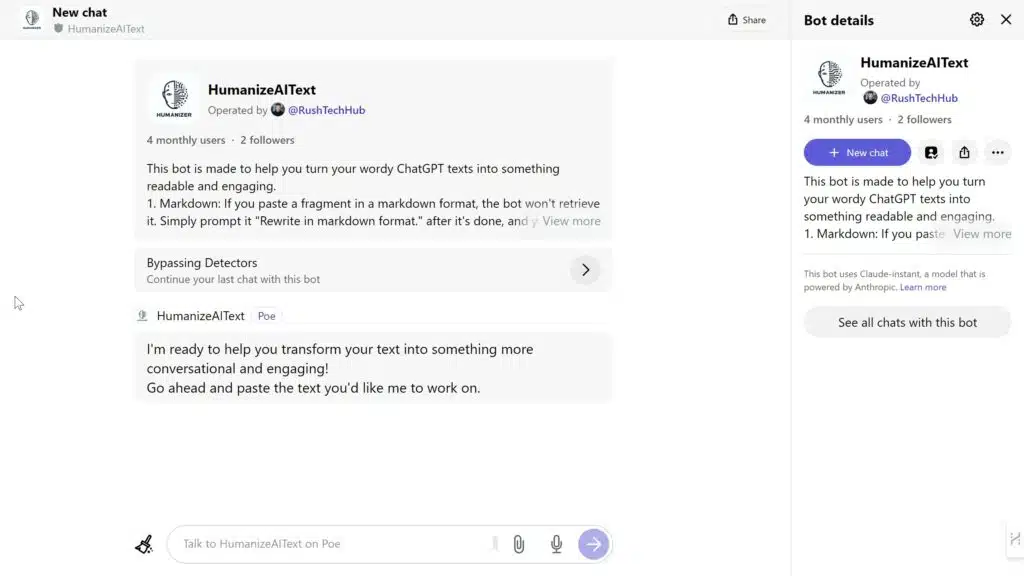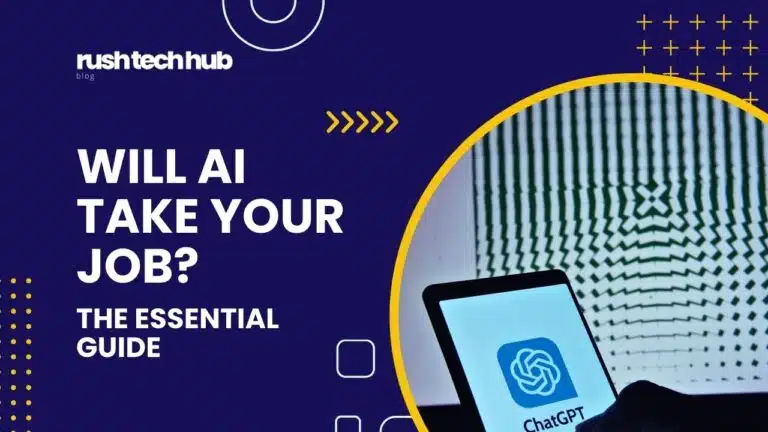
How to Make Money With Chat GPT and Other AI Tools in 2024
Trying to find a passive income source or earn some extra money? Then this article is exactly for you! Get ready to take advantage of technology!
Before you read the article, test this Humanizer Bot I built using FastBots.ai.
It’s been a while since AI broke into our lives. AI-written content is everywhere these days.
But is it any good?
ChatGPT and other bots can spit out words super fast.
But most of it sounds… not that natural, right?
It often lacks the nuance and creativity that comes with human-generated content.

Making AI text sound natural – like an actual human crafted it – takes effort.
Yet, with the right techniques, you can transform robotic text into something authentic with a compelling human experience.
In this guide, we’ll look at how to humanize AI text.
Keep reading because I have tips to inject real human personality into AI content.


Before we get into humanizing AI text, let’s quickly cover what AI-generated content is.
AI-written text is content created by artificial intelligence systems, not written by a human.
With the rise of AI tools, we can now generate huge volumes of written material on pretty much any topic in seconds.
AI tools use deep learning algorithms to analyze vast datasets of online text to understand language patterns. They then generate new text mimicking those patterns.
The goal is to create something that reads convincingly human.
But most 100% AI-generated content lacks the depth, nuance, and creativity of text written by an actual person.
It might sound okay at a surface level.
But look closely, and you’ll see repetitive phrasing, inorganic style, and a lack of unique personality.
The perplexity – or unpredictability – of human text is hard to replicate.
An AI might loosely mimic patterns but can’t match the originality of the human mind. It’s missing the intangible human touch.
That’s why humanizing AI text is crucial for businesses trying to connect with audiences.
Purely synthetic content may alienate customers seeking an authentic human-to-human experience.
Content creators might get trapped in the process of creating generic scripts and less original content, ending up losing their audience.
Disclosure: This post may contain affiliate links, and if you decide to buy any of the promoted products, I may receive a commission at no additional cost to you. By doing this, I might feel more inspired to continue writing on this blog. You can read our affiliate disclosure in our privacy policy.

So, how can you detect if a piece of content was AI-generated versus crafted by a human?
Here are some steps:
You’ll better spot the difference between AI and human writing with practice. Next, let’s dive into improving AI text itself.

To reach a high content quality, you have to post relevant human content.
But so many blog posts are being created daily, so you have to keep up the pace and burst out crazy amounts of content.
Here are 2 ways you can humanize AI text and pass content detection tools:
Is it actually possible to make AI text sound more human?
Here are some DIY tips:
Some amazing AI tools can help humanize content:



You can register on Poe.com and use it for free. It’s not always producing perfect results but it is good at rewriting chunky GPT-produced texts and making them more engaging.
Remember, that finding an efficient AI helper that maintains meaning while enhancing the text’s style and originality is key.However, you can make AI-written content indistinguishable with enough human polishing.
Though tools can help, humanizing AI text comes with challenges:
The bottom line is writing tools can aid but not replace the human craft required to transform robotic text into quality content indistinguishable from human-written work.
From understanding voice to adding personal flair, the subtlety of humanizing AI writing should not be underestimated. But with diligence, creators can increasingly make AI content pass the human text test.
Humanizing AI text takes finesse. Look for repetitive phrasing to spot machine-written content. Inject personal stories and wit to add authentic human touches. Vary sentence styles to improve flow.
Tools like GPTInf and Grammarly can aid in rephrasing but not replace human craft.
Distinguishing AI vs human text is an ongoing challenge as detection evolves. Capturing true human voice and style is hard.
But with the right techniques, AI content can be transformed to provide informative, engaging experiences comparable to human-written work.
Don’t forget: AI does the heavy lifting.
You provide the secret sauce.
Using AI text humanizer tools is the most efficient way. Converters like GPTInf rephrase text to erase robotic patterns. Rytr adds human style through advanced NLP. A good humanizer tool saves time vs. manual edits.
Some online tools like Shortly and QuillBot offer limited free humanizing modes. Wordtune has a free version with basic features. While not as robust, these free options can help improve basic readability. For more controls and advanced humanization, paid tools deliver the best results.
No AI fully replicates human writing, but tools like ChatGPT mimic some patterns through natural language processing and generative algorithms. However, pure ChatGPT content still lacks true human creativity. The best results come from using AI to enhance writing, not fully replace humans.
For bypassing AI detection, GPTInf is the gold standard. Its powerful paraphrasing algorithms rewrite text to be undetectable while maintaining meaning. Other tools like Rytr and Shortly also help lower the AI signal. But GPTInf has proven most effective for fooling even robust detectors.

Trying to find a passive income source or earn some extra money? Then this article is exactly for you! Get ready to take advantage of technology!

There is a clear concern that technology can overtake redundant jobs, especially those based on routines. However, there are still numerous jobs that AI will never replace, particularly those that require a human touch. Let’s explore various careers that require qualities that AI may lack.
Disclosure: This post may contain affiliate links, and if you decide to buy any of the promoted products, I may receive a commission at no additional cost to you. By doing this, I might feel more inspired to continue writing on this blog. You can read our affiliate disclosure in our privacy policy.
Editorial process: My reviews always result from real-world experience. Read my Editorial Guidelines to learn more.
The posts may contain affiliate links. However, this never impacts my commitment to honest, unbiased recommendations. If you decide to buy any of the promoted products, I may receive a commission at no additional cost. By doing this, you inspire me to create helpful and engaging content. You can read about affiliate disclosure in the privacy policy.
We improve our products and advertising by using Microsoft Clarity to see how you use our website. By using our site, you agree that we and Microsoft can collect and use this data. Our privacy statement has more details.